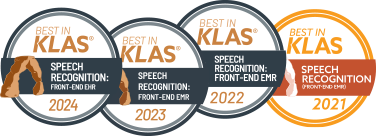The #1 clinical documentation companion
Go beyond dictation with a conversational AI workflow assistant and clinical documentation companion. Dragon Medical One uses artificial intelligence to accurately capture voice-generated content directly into clinical systems. More than just a speech recognition solution, Dragon Medical One can aid, assist, and advise.

Dragon Medical One
Dictate directly into your electronic patient record and navigate using your voice with Nuance’s highly‑accurate clinical speech recognition solution.

Ranked #1 Best in KLAS for 4 consecutive years
Named Best in KLAS: Software & Services award for four consecutive years, 2021-2024, Dragon Medical One is secure, trusted, and proven.
Documentation aid & clinical noting
Reduce the burden of clinical documentation
Dragon Medical One supports a more productive documentation experience before, during, and after the patient consultation. Advanced speech recognition delivers faster, simpler, and more complete clinical notes and documentation.
Unrivalled accuracy
Dragon Medical One requires no voice profile training, a single cloud based profile is auto established at first use powered by AI algorithms and a first‑class professional medical vocabulary. Accent adjustments and microphone calibration are automatic, providing even greater accuracy, and an optimal clinician experience from the start.
Dictation done better
Dictate at cursor, directly into the application of your choice, or use a dictation box to access your notes and transfer text between apps. Anchor dictation allows you to maintain focus as you move between multiple apps.
Smartphone mic
When paired with PowerMic Mobile, any workstation becomes a dictation station, giving clinicians freedom to document notes using their smartphone as a secure wireless microphone.
AutoText
Reduce time and eliminate repetitive data entry by automating how commonly used content and information is added to clinical notes. Customised templates can be shared across users, departments, and organisations.
Advanced commands
Conquer the clicks and optimise workflows with advanced step-by-step commands. Format, correct, and navigate notes and records quickly and easily using just your voice.
Industry-leading architecture
With remarkable responsiveness and resilience, this GDPR - compliant and ISO 27001 - certified solution enables broad integration and seamless support for both browser and web-based EPRs—giving you the flexibility you need in the environment you want.
Your path to DAX Copilot begins now with Dragon Medical One
Dragon Medical One aids with your documentation workflow and assists you within the EPR and beyond so you can achieve higher levels of quality across care settings.
Dragon Medical One is your gateway to DAX Copilot.
DAX Copilot is the next step combining generative and ambient AI with conversational AI.
Clinical documentation workflow assistant
Conquer the clicks using advanced voice commands
Simplify repetitive tasks such as EPR navigation, orders, and signing notes by using the integrated voice capabilities of Dragon Medical One. Go beyond clinical workflows to draft personal emails, navigate Microsoft Office documents, and search the web by using your voice.

Secure and compliant
Dragon Medical One runs on the Microsoft Azure hosting infrastructure in the UK supporting the high availability, business continuity, and security demands of the NHS.
Act on insights with our customer success organisation
Nuance has many years of experience working closely with hospitals to support deployment and adoption of our solutions. As part of our Customer Success Organisation, we provide regular reports for monitoring KPI trends, measuring ROI, responding to changes in adoption and demonstrating benefits.
Nuance professional services
Personalised experience and improved EPR adoption
Our team of experts give you all the support you need to plan, deploy and adopt our cloud platform.
Testimonials
What customers are saying
Resources
Blog
- Meet the NHS GP saving an hour a day—and increasing patient safety—with Dragon Medical One(Open a new window)
- How cloud technology can alleviate pressures on the NHS(Open a new window)
- Dragon Medical One supports clinical documentation across the care continuum(Open a new window)
- An interview with Dr Simon Wallace on clinician burnout(Open a new window)
ePapers
Videos
- Forget about typing with Dragon Medical One
- Alleviate the burden of clinical documentation for hospital staff with Dragon Medical One
- Reduce administrative burden for nurses with Dragon Medical One
- Boost productivity and efficiency with Dragon Medical One
- GP testimonial for Dragon Medical
- Speech-enabling the Frimley (Epic) EPR
Case studies
Press releases
- Nuance Dragon Medical One Earns #1 Best in KLAS 2022 Award for Speech Recognition: Front-End EMR(Open a new window)
- Guy's and St Thomas' NHS Foundation Trust Selects Nuance Dragon Medical One As Part of a Large-Scale Digital Transformation(Open a new window)
- Microsoft accelerates industry cloud strategy for healthcare with the acquisition of Nuance(Open a new window)


